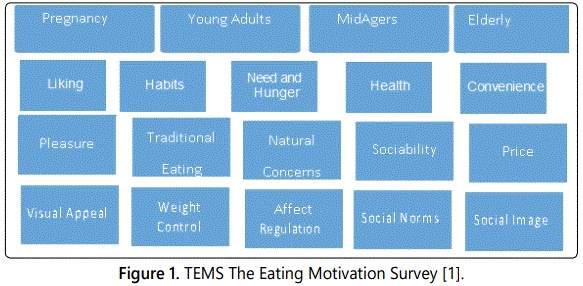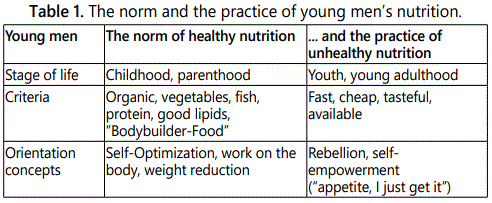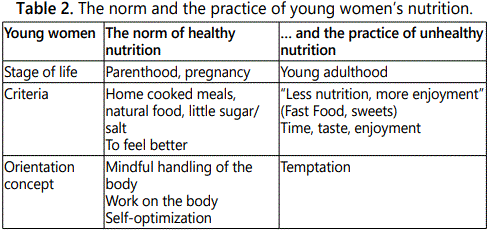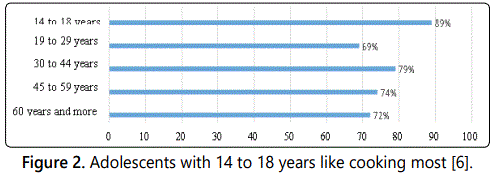Research Article
Factors Influencing the Nutrition Behaviour of Young Adults
Gender Studies in Science and Engineering, Technical University of Munich, Germany
*Corresponding author: Alexandra Sept, Gender Studies in Science and Engineering, Technical University of Munich, Germany, E-mail: alexandra.sept@tum.de
Received: June 20, 2019 Accepted: August 9, 2019 Published: August 23, 2019
Citation: Sept A. Factors Influencing the Nutrition Behaviour of Young Adults. Int J Obes Nutr Sci. 2019; 1(1): 22-26.doi: 10.18689/ijons-1000104
Copyright: © 2019 The Author(s). This work is licensed under a Creative Commons Attribution 4.0 International License, which permits unrestricted use, distribution, and reproduction in any medium, provided the original work is properly cited.
Abstract
Nutritional behaviour differs not only between the sexes, but also between the different age groups. The reasons for this are not only the preferences and aversions caused by social and cultural conditions such as wars or regional cuisine, but also individual and social circumstances and living conditions. This also includes status passages and developmental tasks which have to be mastered in certain age groups and which influence nutritional behaviour through the associated changes. With the help of biographical interviews with young adults it was possible to find out, that for adolescents and young adults the motives and factors for nutrition behaviour are different, than for other age groups, because of the many changes in living conditions. Most of all moving out of parentsʼ homes is associated with changes in eating habits and food consumption. The aim of the project was to collect socio-cultural explanatory patterns for the nutritional behaviour of different groups of people in order to be able to integrate them both into direct product development for food and into the design of nutrition and healthy eating information campaigns.
Keywords: Nutrition behaviour; Young adults; Social factors; Gender and Diversity; Social science.
Introduction
This article was written as part of the interdisciplinary research project “enable-healthy food choices in all stages of life”. The main focus is on persons with a higher risk of nutrition-caused diseases.
In nutrition research, the focus is predominantly on scientific approaches, but it should not be forgotten that the social science aspects of nutrition also have to be considered. Above all, questions concerning nutrition and consumer habits can be answered by this. The TEMS (The Eating Motivation Survey) was able to explain that nutrition behaviour is characterized by different motives and influencing factors that describe what people eat, when and why (Figure 1). They identified the following motives [1].

These motives illustrate the complexity of nutrition behaviour and influence the individual behavioural patterns to varying force and should be taken into account when considering habits [2]. In this research the focus is on the nutrition behaviour and the nutrition habits of young adults at the age of 18 to 25 years.
Young adults are faced with many challenges and changes: In addition to finding their identity in the gender role and building up a system of moral and ethic, their own future perspectives have to be developed. Essential is the replacement of the parents, which is mainly obtained by moving out of the parental home and is associated with many changes and new situations for the adolescents. Moving to their own home is a step in their life, which often causes changes in the personal nutrition.
With the move from the parental home, the self-sufficiency is on and an own lifestyle and nutritional style has to be developed and there are new freedoms and opportunities to try out. Because the moving is a big step in life of the young adults, the focus is not on the nutrition. Main criteria the nutrition has to comply with are fast, easy, delicious and cheap.
The consumption of junk food and fast food, for example, is particularly attractive for young people, as it is a distinction from the adult culture of eating, which is characterized mainly by rules such as eating with cutlery [3]. Although food has the same function for all ages, the different meanings between the nutrition habits of adolescents and adults become clear. In addition to achieving autonomy, personality development is also a developmental task in youth. This also includes the nutritional style, which is developed through the unconscious examination of the eating patterns of adults.
Materials and Methods
At the beginning of the research process there were questions like: Why do people eat like they eat? How are they driven? How can we bring the gained knowledge into practice? These questions could be specified more precisely in the course of research and analysis of existing literature and studies on social science nutrition research. Because nutrition is a highly gendered and diverse phenomenon [4,5], the following research questions could be developed:
- What are individual motives for resilience and change in nutrition behavior – especially for adolescent?
- What are relevant gender and diversity dimensions to influence individual behavior change?
Analysis of the state of research
Individual eating habits cannot be explained genetically alone, but are also influenced by the social environment and cultural factors. The (change-resistant) eating behaviour appears to be irrational in some cases. For this reason, current studies from nutrition research, gender medicine, sociology, psychology and gender studies [6-8] have been continuously analysed and integrated into the research process.
Focus groups
Qualitative research methods are useful in identifying complex motivations for resilience and behavioural changes in nutrition behaviour, as they allow an in-depth analysis of the individual needs, desires and motivations of the target groups. Here information can be collected and narratives generated, and group-dynamic argumentation patterns can be made visible in the context of a communication situation close to everyday life in order to be able to analyse opinion-forming processes [9-11].
In this way, they contribute to the sustainable improvement of the product development in the nutrition and food sector. In addition, the results can be used for information campaigns and support programmes for healthy nutrition. Focus groups were therefore conducted as a form of qualitative research methods that generate productive data. The communication process was recorded, prepared and evaluated for qualitative analysis. The guidelines for the focus groups were drawn up on the basis of the results of the literature study. Then the participants were recruited and the focus groups conducted and analysed. In order to attract people to participate, the participation was incentivised and the costs of travel were covered. A total of six focus groups with 10-20 persons each (gender ratio balanced) were carried out in Bavaria, Germany. The duration of each focus group was approximately two hours. The participants were recruited via the project and posters in community centres, gyms and neighbourhood meetings. Subsequently, the recordings of the focus groups were transcribed externally and evaluated with the MAXQDA analysis software.
Biographical interviews
The interviews were used for a deeper analysis of the nutritional habits (needs, wishes, motives) in the target groups. First, the interview guideline was developed on the basis of the findings of the focus group evaluations. The main focus here was on nutrition practices, taking into account the relevant gender and diversity dimensions. In order to depict the different nutritional practices and life situations of the target groups as accurately as possible, various additional questions were developed in addition to a basic framework of questions to supplement the guidelines.
The interview participants were then recruited and the interviews conducted. 18 individual interviews were conducted with young adults, middle-aged adults and senior citizens of about 60 to 90 minutes each. The participants were recruited through the same channels as the focus group participants. Participation was also incentivised and travel costs were covered. All interviews were recorded and transcribed and then evaluated with the MAXQDA software.
Results
In the adolescence, there are many specific development tasks [12]. First of all it is important, that adolescents build a gender identity by dealing with different social roles and develop friendships with both sexes. They have to accept their physique and keeping it healthy and learn what is good for them and what is bad (alcohol, drugs, fast food…). Also it is important, that they achieve emotional independence of parents and other adults. In the time of growing up, they have to prepare for marriage and family life, this means to enter a relationship or get a concept about the own future. Besides, preparing for an economic career, further education, trainings or study and acquiring values, an ethical system and an ideology for the behavior is another development task. At last, the young adults should desire and achieve socially responsible behavior. The Independence of parents is often achieved through moving from parental home. The moving is a status passage and leads to many changes in the life of young adults. They have new independence, freedom, new possibilities and less rules. With regards to nutritional behaviour this means, that no table rules, like eating with knife and fork and fixed mealtimes must be followed). Previous behaviour is reconsidered and maintained or changed. The young adults question their previous nutrition behaviour and adapt it to their everyday life, so their own nutritional habits must be developed.
If you look on the nutritional behaviour of adolescents, there are two different trends: on one side the Fast Food consumption is at a very high level and on the other side many adolescents follow a Fitness-Lifestyle with healthy nutrition and restrictive diets. The average of young means daily calorie intake is as twice as much as for young women. 23 percent of the men under 30 describe themselves as “Fast-Food-Fans” [13]. 56% of the men and 33% of the women under 30 donʼt think about nutrition values and calories [13]. On the other side you have a healthy lifestyle with “Bodybuilder-Food” like the adolescents call “rice with chicken and vegetables”.
One focus of the biographical interviews with the adolescents was the situation and nutrition practice and how it changed within the last years. The situation of the participants at home in the last years of school before the moving from the parental home or starting their study or training was described very similar. The family was eating together or at least eating partially together. The meals were home cooked, healthy, warm, fresh and balanced and were mainly cooked by the mother. The participants described regulated meal times such as breakfast, lunch, dinner, that have taken place always at the same time. When somebody was not able to join lunch or dinner, he or she got leftovers of the warm meals. The adolescents were not explicitly asked about the moving from parents home, but wanted to know, about the course of their nutrition and changes. The questioned adolescents named fast food, delivery service and finished products as their daily nutrition practice. Also they said, that is important, that the meal preparation is fast and the food is cheap. The mealtimes after the moving out were unregulated and the meals unhealthy and unbalanced. This shows a clear contrast to the nutritional practice at parental home and the new independence, the freedom and the new possibilities such as less rules lead to a completely different nutrition behaviour.
The students told us to get lazier and have no time for cooking at home so they consumed finished and frozen products:
Studies: “When you study, then you get a bit lazier. I have cooked less and bought much more finished products” (M, 23)
“If you had no time and no desire to cook, then it was rather unhealthy and was just frozen products” (M, 24)
Also because of the study or vocational training, the moving from parental home and the new situation, pressure is a factor that influences nutrition and because of tension their nutrition became unhealthier:
Pressure: “I was pretty frustrated in the evening and then I always had food” (F, 19)
“It tended to get unhealthier as it became more stressful” (M, 24)
The participants, that already have been moved out from parental home, mentioned that they have to safe money, because of the beginning of a study or vocational training. So especially from 18 to 25 years there is not much money for disposal so the food must be cheap, like the often described noodles with tomato sauce:
Money: “Depending on the money, sometimes you buy just the easiest food for yourself”, (M, 24)
“The food was unhealthy and the easiest, cheapest was just right” (M, 24).
Some of the participants mentioned, that developing a own nutrition behavior took time:
Habituation: “In the beginning everything had to adjust first” (F, 19)
But: Income and habits are estimated to be highly relevant for nutrition behaviour in all age groups. Not only study, also starting training influences the nutrition because of the new situation and associated factors like pressure, time and money.
Other important factors that have an influence on the nutrition of young adults are persons in every-day-life like flat mates or partnerships. It was striking, that only the positive influence of the flat mates was described. The participants thought about their nutrition and compared it to the nutrition of the flat mates, especially when their nutritional style was healthier. Also the pushing- factor of room – or flat mates was described but also only in a positive context:
Flatmates: “In the refrigerator, she has always vegetables and I have just convenience food” (F, 23)
“I see, that she cares a lot more about her nutrition. She has regulated mealtimes. That affects me, because that makes me think, why Iʼm not like that” (F, 23)
“Sometimes it was very healthy because of a roommate who ate very healthy and we have pushed each other” (M, 23)
“Due to roommates, very healthy. Low carb in the evenening, nothing un-healthy” (M, 24).
The influence of a partnership can be positive or negative. It was striking that the girls in a relationship mostly said, that they eat less healthy because of their partner. Boys in a relationship told us both, a positive influence because of cooking fresh and eating together and itʼs easy, especially when the girl has a healthy nutrition style:
Partnership: “She eats healthy, so ist easy to join and do it too” (M, 24)
“My girlfriend also has influence. She is vegetarian and if we cook for each other, we cook only veggie stuff” (M, 22) Also the cooking-skills of adolescents must be taken into account. Mainly young men told, that they canʼt cook, but would like to learn it because it tastes better than finished food like lasagne:
Abilities: “Iʼm quite willing. Because it is just tasteful, it makes a difference”. (M, 22)
“I canʼt cook at all. I can cook noodles with finished noodles” (M, 22)
Young adults that are moved from parental home have to purchase their food, prepare and cook in on their own. For the questioned adolescents it was important that the meals they cook at home include not many products, so their purchase is easier and they do not have to think about much ingredients, that must be bought:
Purchase: “You have to do the purchase yourself now. You have to think, should I cook or should I just do something fastʼ. I just shove something into the oven and otherwise the mother took care of the meals” (F, 23).
The social factor of eating was also accentuated: Eating alone was accentuated in a negative way. The questioned adolescents told us to have no desire of eating alone, so they eat food to go or do something else while eating:
To be alone: “Whenever I eat, I usually eat alone and usually sneak in or eat food to go and do something else” (F, 23)
“The listleness to cook alone. So sit down alone and to eat alone” (F, 23)
With regard to the attitudes towards to-go products, the adolescents, both, the young men and women, were very glad about this products because for they it is a comfortable and easy way to get food when they donʼt want to spend time or effort:
“I like it, the products are transparently packed and I am also simple, a bit comfortable. You donʼt have to cut pineapple, you just eat it, so I like it. You just donʼt need that much time”. (F, 23)
“My taste has probably gotten used to fast food and convenience food and frozen food probably due to study. That was developed in adulthood. If you consume more often, then you get used to it. The interplay of taste and comfort, because you not have to do anything, you just have to pay. So nothing, you need no physical effort to eat that. Itʼs both, taste, which is quite good as well as the simplicity of preparation” (M, 24).
Discussion
The different motives for the individual nutritional behaviour are complex. Habits that result from social and cultural factors and trends shape the daily nutrition. Currently, there is a de-drematization, de-temporalization and de-naturalization of nutrition [14]. In addition, a pluralization of nutritional styles can be observed [14]. Gender is a relevant factor influencing nutrition [15]. This is evident because women show more health-conscious behaviour than men [15,16] and men are less well integrated in health-promoting offers than women [17] (Tables 1 and 2).
The literature proves the simultaneity of unhealthy nutritional practices as paradoxical independence from incorporated nutritional knowledge and emancipatory resilience from an expertise health imperative [18]. This also emerged from the focus groups and interviews.
The results from the respective gender-homogeneous group discussions with young men and young women (18-25 years) showed that the interviewees were always in a field of tension between the norm of a healthy nutrition and their everyday practice of unhealthy nutrition. Healthy eating is associated with physical sensation (“feeling better”) and emotional and social components (“much more fun when two or three people are in the kitchen”). Motives for the practice of the unhealthy nutrition of young women were mainly the time pressure (hence the consumption of fast food), as well as the taste (e.g. with ice). For young men, availability and price were also reasons for an unhealthy nutrition. A consensus for the ideal finished product was reached in the groups: It is healthy, quick to prepare, inexpensive and tastes good.


The evaluation of the biographical interviews showed that the housing situation is of importance for the design of nutrition, especially in young adulthood. Since moving out of the family home often takes place at this age, this status passage leads to a conscious or unconscious retention or change of personal nutritional behaviour. It was important for the nutrition of the young adults whether they lived alone, their partner or with a roommate. The housing situation has an effect not only on the consumption of certain foods, but also on the framework of meals. It was noticeable that the interviewees in turn postpone a healthier eating behaviour into the future and often associate it with parenthood.

Although women and men at the age from 18 to 25 years consume much fast food, they like cooking. The German nutrition report 2017 shows that adolescents like cooking more than adults and elderly, but only 20 percent of the German adolescents are cooking daily (Figure 2). This indicates the potential that remains untapped in this age group. It must be considered here to improve nutrition sustainably and to motivate more adolescents to cook daily healthy and balanced.
Conclusion
Within the framework of the research project enable, two focus groups with young women and men between the age of 18 and 25 and guided narrative interviews were conducted. They described the personally perceived changes in nutrition behavior and provided information on the criteria that determine these changes. In this work the focus was on gender-specific concepts and the practice of nutritional behavior in adolescence and young adulthood. Especially for this young age group are the influence of the leisure time and the peer group. Also social media is very important; it causes a high competition pressure, like comparing the bodies, show a healthy lifestyle, cooking skills etc. Changes in nutrition behavior in this age group are at status passages like start studying or vocational training, enter into a relationship or – most important- moving from the parental home. Before moving, the adolescents had mostly regular meals, fresh, balanced, warm meals. Their meals were mostly prepared, purchased and cooked by their parents. At least once a day they described to have a collective family meal. The nutrition situation after moving from the parental home was much different. The participants mentioned to consume much fast food and convenience food. They described to eat more irregular and alone, the preparation, purchase, and cooking was by their self. They depict their moving as a new situation that has to settle down first. The main influences on the nutrition of adolescents are: Studies/vocational training, pressure, money, living situation: at parental home, with a flatmate, alone; relationship and time.
Conflict of Interest
No conflict of interest was reported by the author.
Funding
This work was supported by German Federal Ministry of Education and Research (BMBF) as part of the interdisciplinary research cluster “enable- healthy food choices in all stages of life”.
References
- Renner B, Sproesser G, Strohbach S, Schupp HT. Why we eat what we eat. The Eating Motivation Survey (TEMS). Appetite. 2012; 59(1): 117-128. doi: 10.1016/j.appet.2012.04.004
- Witherly SA. Why humans like junk food. iUniverse. 2007.
- Rose L, Seehaus R. Doing Gender and Doing Diversity with Food. In: Graff U, Kolodzig K, Johann N (eds). Ethnography - Pedagogy - Gender. Children, childhoods and childhood research. Springer VS, Wiesbaden. 2016; 12: 173-186.
- Beardsworth A, Bryman A, Keil T, Goode, J, Haslam C, Lancashire E. Women, men and food. The significance of gender for nutritional attitudes and choices. Br Food J. 2002; 104: 470-491. doi: 10.1108/00070700210418767
- Kelly A, Ciclitira K. Eating and drinking habits of young London-based Irish men. A qualitative study. J Gend Stud. 2011; 20(3): 223-235. doi: 10.1080/09589236.2011.593322
- Spencer RA, Rehman L, Kirk SF. Understanding gender norms, nutrition, and physical activity in adolescent girls: a scoping review. Int J Behav Nutr Phys Act. 2015; 12: 6: doi: 10.1186/s12966-015-0166-8
- Flick U. Qualitative social research: An introduction. Rowohlt-Taschenbuch Verlag Publisher. 2006.
- Farnsworth J, Boon B. Analysing group dynamics within the focus group. Qual Res. 2010; 10(5): 605-624. doi: 10.1177/1468794110375223
- Krueger R, Casey MA. Focus Groups: A Practical Guide for Applied Research. Sage Publications. 2014.
- Hannover B, Zander L, Wolter I. Development, socialization and learning. Educational Psychology. 6th Edition, Weinheim: Beltz Publisher. 2014.
- Bundesministerium für Ernährung und Land wirtschaft. Germany, how it eats - The BMEL nutrition report 2017. 2017.
- Prahl HW, Setzwein M. Sociology of nutrition. Wiesbaden, Germany: VS Verlag for Social Sciences. 1999.
- Setzwein M. Diet - Body – Gender. On the social construction of gender in the culinary context. Research sociology. Volume 199. Wiesbaden, Germany: VS Verlag for Social Sciences. 2004.
- Kersting M, Alexy U, Kroke A, Lentze MJ. Child nutrition in Germany. Kinderernährung in Deutschland. Bundesgesundheitsblatt- Gesundheitsforschung – Gesundheitsschutz. 2004; 47(3): 213-218. doi: 10.1007/s00103-003-0796-x
- Kruse A, Schmitt E. Social inequality, health and care in old age. Bundesgesundheitsbl. 2016; 59(2): 252-258. doi: 10.1007/s00103-015-2285-4
- Bengel J, Lyssenko L. Resilience and psychological protective factors in adulthood : Research into psychological protective factors of adult health. Forschung und Praxis der Gesundheitsförderung. 2012; doi: 10.4126/38m00511160


